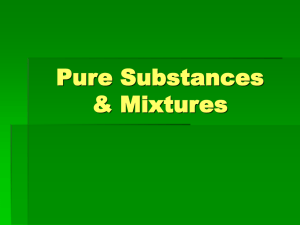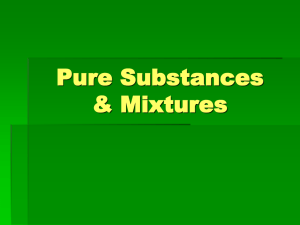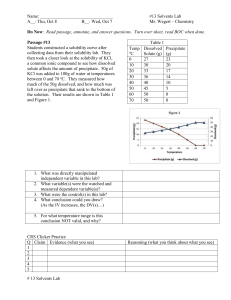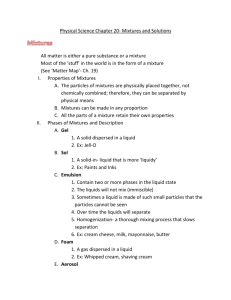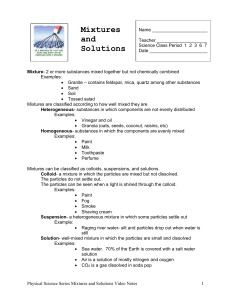Mix & Flow
advertisement
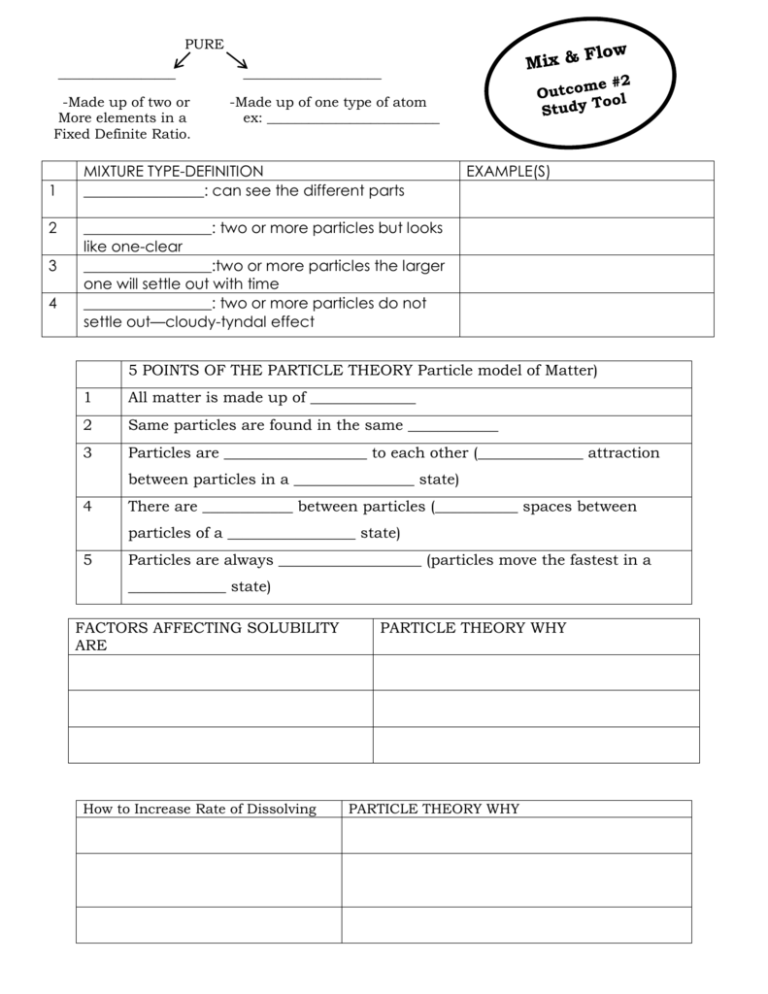
PURE _________________ -Made up of two or More elements in a Fixed Definite Ratio. 1 2 3 4 ____________________ -Made up of one type of atom ex: _________________________ MIXTURE TYPE-DEFINITION ________________: can see the different parts EXAMPLE(S) _________________: two or more particles but looks like one-clear _________________:two or more particles the larger one will settle out with time _________________: two or more particles do not settle out—cloudy-tyndal effect 5 POINTS OF THE PARTICLE THEORY Particle model of Matter) 1 All matter is made up of ______________ 2 Same particles are found in the same ____________ 3 Particles are ___________________ to each other (______________ attraction between particles in a ________________ state) 4 There are ____________ between particles (___________ spaces between particles of a _________________ state) 5 Particles are always ___________________ (particles move the fastest in a _____________ state) FACTORS AFFECTING SOLUBILITY ARE How to Increase Rate of Dissolving PARTICLE THEORY WHY PARTICLE THEORY WHY LEARNING OUTCOME #2 STUDY GUIDE: VARIABLES OF A LAB: manipulated, responding, controlled PARTICLE MODEL (5 points used to explain) MATTER CLASSIFIED AS MIXTURES: made up of ______ or more types of ________________ (know examples) Mechanical mixtures: Colloids: Suspensions: Solutions: MATTER CLASSIFIED AS PURE: (know examples used in class) Elements: Compounds MIXTURES CLASSIFIED AS: Heterogeneous mixtures: (___________________, _________________, ______________) Homogeneous mixtures: look like ________ ( ________________________) PARTS OF A SOLUTION: Solute: Solvent: Soluble vs. insoluble TERMS TO DESCRIBE A SOLUTION Dilute vs. Concentrated solutions Unsaturated vs. Saturated solutions Saturation point Written Concentration of a solution Solubility THREE FACTORS AFFECTING SOLUBILITY OF A SOLUTION (particle theory tod explain) 1. 2. 3. THREE FACTORS AFFECTING THE RATE OF DISSOLVING (particle theory to explain) 1. 2. 3. READING and EXPLAINING SOLUBILTY GRAPHS Classify the following examples into the appropriate category. Milk, mud puddle, pop, clean air, granola cereal, cloud, salt water, pizza, hair gel, tea, coffee, tomato juice, smog, tap water, sandwich, peanut butter, gold jewelry, apple juice Mechanical Colloid MIXTURES Suspension Solution Name the categories below for mixtures and classify the above examples into the following two categories. __________________is a mixture where the components that make up the mixture are uniformly distributed throughout the mixture. Appears to look like one substance. Ex: _____________________:is a mixture where the components of the mixture are not uniform or have localized regions with different properties. Ex: Classify the following examples into the appropriate category. Oxygen, sugar, salt, baking soda, hydrogen, neon, gold, distilled water (H2O) PURE MATTER Elements Compounds What is the difference between soluble and insoluble? To make a glass of lemonade you dissolved sugar and lemon juice into water. The solute(s) is/are ____________________________ and the solvent(s) is/are ___________________ Solution Is dissolved Does the dissolving A dilute solution has _______________ solute dissolved into the ______________ A concentrated solution has ___________ of ___________________ dissolved into the ______________________ A solution that can still dissolve more solute is called an ___________________________ solution. A solution that cannot dissolve anymore solute is called a _________________________ solution. If you write the amount of solute dissolved into a certain amount of solvent you would have written the _______________________ of the solution. If 33g of solute is dissolved into 50g of water what is the concentration of the solution? ________________________ What is meant by the solubility of a solution?______________________________________________ __________________________________________________________________________________________ Sam had 135mL of water in which he put 23g of sugar and then heated it to 37˚C. What is the solubility of Sam’s solution? _________________ Convert Sam’s solution and compare to Sally’s solution of 17.1g/100mL @ 37˚C. Which substance is more soluble at 60˚C? What is the solubility of NaCl at 0˚C? If you had 100g of each solute at 80˚C which substance would be saturated? How much solute of KNO3 is needed to make a saturated solution at 0˚C? Draw what the solubility of the gas CO2 on the graph. What is the connection to thermal pollution? Sam heard that water was called the _____________________ solvent, because he was told that it dissolves many types of solute. To test this statement he took six different solutes and tried to dissolve them into 100mL of water. He then did the same but used vegetable oil and alcohol as the solvent. The manipulated variable in this lab was ________________________________ The responding variable in this lab was _________________________________ List two controlled variables Sam should have used _________________________





